Barcelona... The magical city of lights, music and monuments
Barcelona... the city of the lights, music and where people never sleep...
During my journey, I took the flexibus for only 20 euros from Marseille to reach this amazing Spanish city, located on the northeast coast of the Iberian peninsula and spread over approximately five kilometres of wide plain facing the Mediterranean sea. The weather was warm, sunny and ideal for big trips to discover this amazing city with so much monuments and castles.
At first, I had to locate myself inside of the city as it is really huge so Google maps must be always opened on the phone and the GPS can really be of a big help. I bought a pass of transport that allowed me to take buses and metros for 32 euros and that permit me the best transport for lower price within four days.
1- Arc of Triomf
The Arc de Triomf is one of the most famous and appreciated monuments of the Catalan capital. A veritable symbol of Barcelona's singularity, this 30 m high building stands majestically between Passeig de Sant Joan and Passeig Lluís Companys, with a very beautiful zoom on the center of Catalonia. Originally built at first as a gateway to an exhibition, it allowed after the access to the Ciutadella Park, the fair's fairground. Out of respect for the provinces and nations participating in the event, Vilaseca chooses to assign classical proportions to the bow. Indeed, although the majority of triumphal arches were built to commemorate a great military victory or a national event, the Arc de Triomf of Barcelona was conceived with the aim of uniting the different nations present. The arch is nevertheless distinguished from other buildings by its red bricks, a characteristic of this amazing building.
By walking in the Passeig de Llouis Companys, I was admiring the huge amazing monument in red bricks, thats is the Arc de Triomf de Barcelona. It was the main access gate for the Barcelona wild fair. In fact, the arc crosses an entire wide avenue leading by walking to the very famous Parc de la Ciutadella. The monument was made by stone sculptures red and white, huge in shape and with the most amazing detailed architecture.
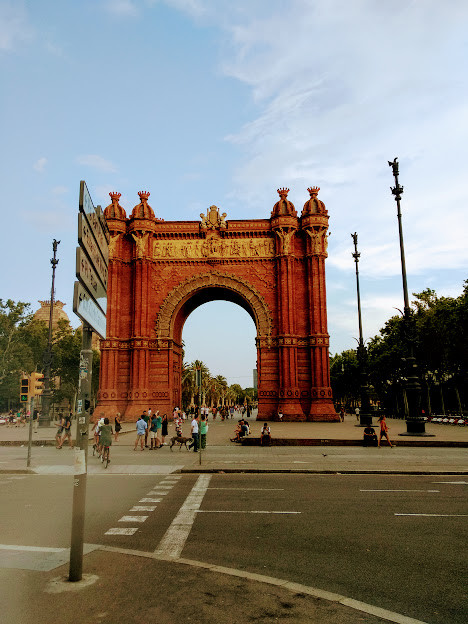
It is very pleasant to walk near the Arc de Triomf. Although this place is very touristic, this spacious place makes it possible to enjoy Barcelona calmly. Between skaters, athletes, magicians, craftsmen and fairgrounds making huge soap bubbles for young and old, the arc seems to materialize the soul of Barcelona. We can really let ourselves be charmed by this building with red bricks, until falling in love.
2- Parc de la Ciutadella
The whole avenue from the beginning of the Arc of Triomf was awesome, allowing to hang out with friends and destress ourselves. In the entrance of Parc de la Ciutadella we could distinguish the Castle of the Three Dragons with its fabulous architecture, the green wide plains of grass decorating the park, so clean and so amazing, allowing people to relax and to do picnics with music everywhere. This Ciutadella Park is located in the district of Ciutat Vella in Barcelona. This large park of about 17 hectares forms an oasis of greenery close to the historic area of Barcelona. The Ciutadella Park is considered the lung of the city, like Central Park in New York. Its exceptional history is mainly linked to that of the World Fair and the demolition of the military citadel of Barcelona. Many tourists and locals go there mainly to have fun and have a good time with family or friends. Nothing more pleasant than to enjoy a good sunbath, comfortably installed on the lawns, enjoying a picnic with friends.
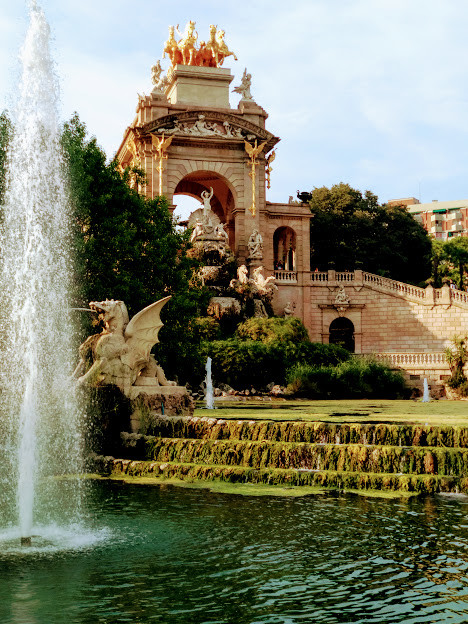
We decided to do a picnic in nature and enjoy this awesome view in front of the Quadriga De l'aurora on the top of the fountain de La Cascada, where we could see water overflowing inside a lake. This cascade was decorated with stairs, and we could discover it by riding to the top to reach the big statue decorated in golden color. Then we could enjoy a tour in the lake where we could pilote a boat by ourselves. The wide variety of attractions within the park meets the needs and tastes of each. From its impressive zoo to its lake and its sculptures, its museum or its fountain designed by Josep Fontsere, the park offers a multitude of activities for both adults and children. The park is also ideal for sports such as boating, cycling or jogging. You can also rent bikes and boats in the park if you do not want to clutter.
For only 6 euros we could spend like half an hour in the boat crossing the water of the lake. The lake was really amazingly beautiful with ducks all arounds and palm trees. It is really an awesome experience to pilote the boat alone and also for a cheap price. Near the Parc de la Ciutadella we could access also a zoo with different cute animals all around, and the Museum of Natural Sciences, that comprises the Museum of Zoology and the Museum of Geology, both sited inside the park with many amazing monuments and sculptures.
The lake of Parc de la Ciutadella attract also many visitors that say the lake is a very romantic place where people can enjoy romantic moonlight walks. For locals it is rather a friendly place where people can contemplate turtles and fish or stroll on the rocks. Near the lake exists a lush vegetation. The reputation of "lung of Barcelona" derives its origin. It is also interesting to take some shots of the banana park, with its very original and particular form due to its great abundance of trees and green places.
The famous Catalan architect, Antonio Gaudí, at the beginning of his career participated in the design of an amazing architecture golden statue. The design of this waterfall statue was inspired by the Trevi Fountain in Rome. On either side of the structure, two steps similar to the claws of a gigantic crab can be seen. These steps provide access to a small podium located in the center of the monument. At this place is a sculpture (created by Venanci Vallmitjana) representing the birth of Venus, standing on a shell. This monument is accompanied by several other sculptures made by Catalan artists of the late 19th century.
3- Sagrada Familia
Visiting Barcelona can not be done without doing a big visit to the great Sagrada Familia. Like many architectural buildings in Barcelona, the Sagrada Familia was, and continues to be, controversial. For years, scholars have been debating whether today's engineers are too different (or not) from the original vision of architect Antoni Gaudí (who died when only a quarter of the project was completed). And while many citizens consider the Sagrada Familia to be the greatest Catalan success in terms of architecture, others consider the structure as a rough and expensive imitation of it. Despite the bickering, it is difficult not to be caught by the magic of this place which, until its completion after years of construction, will be the largest religious building in Europe.
Parc Güell as well is one of Gaudí's greatest successes in urban architecture and shows the sculptor in his most natural side. While visiting Barcelona it is necessarily to have a visit to the famous park. Using the hills of Collserola as a backdrop, Gaudí designed an architectural park whose structures (houses, fountains, pillars, walkways) often seem to be extensions of nature. The columns rise like tree trunks, the arches are serrated like entrances of caves, and the fountains are guarded by giant lizards whose scales are in mosaic tiles. When you follow the steep path and get higher in the steep hill, the panoramic views that await you at the top are breathtaking! As with many other attractions to visit in Barcelona, it is wise to buy tickets in advance in internet, since the park only allows only 400 visitors per half hour. You can also take a guided tour of Park Güell, which is possible, as plan B.
We went out of the park to discover the Plaça de Catalunya, where were sited many great big malls for shopping like El Corte Inglés. In the big square were disposed many gardens all around with very beautiful fountains. The Plaza de España was another emblematic part of the city with so much great architecture, especially of the big mall Las Arenas, a bullring that has been converted into a shopping center where we could discover many great restaurants.
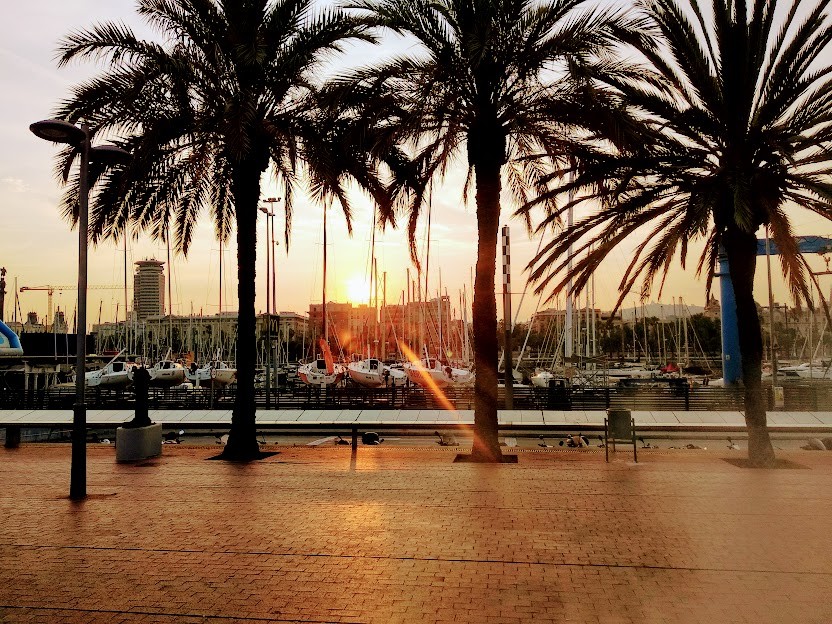
A view on all the city could be seen in the top after accessing an elevator inside of this huge building. Plaza de España, which represents one of Barcelona's most important squares, is constituid by The Venetian Towers observed by the Avinguda de la Reina Maria Cristina, Plaza de toros de Las Arenas and the Museu Nacional d'Art de Catalunya, and Parc de Joan Miró.
The national Palau was an immense historical palace with so much amazing and beautiful conserved architecture and a museum of art inside. The entry cost, only 10 euros, to be able to see the most breath taking masterpieces from the most famous painters. At night, we could follow and enjoy the magical spectacle that was set up especially in weekends free in the street. This is the show of Font Màgica de Montjuïc, which is a Magic Fountain of Montjuïc situated below the Palau Nacional on the Montjuïc mountain and near the Plaça d'Espanya. The show lasts one hour, begins from 9 pm with great diversified colors in different landscapes of water overlowing from the fountain and doing with music a harmonious melody and landscape to visitors. Performances include film, classical, and modern music and pop music. Then we took a tour by bicycle while having our own transporter with music on and a lot of fun during the journey to the main avenue of the city, especially by night, which is Las Ramblas.
The Barri Gòtic retains a labyrinthine street plan, with small squares and streets, many of which connect onto the Rambla. To the south was constructed the Maremàgnum, which is an awesome huge commercial center with many restaurants with a superbe view on the sea and on Barcelona port.
The Rambla also hosts amazing buildings and theatres such as the Gran Teatre del Liceu, the Teatre Principal, the Centre d'Art Santa Mònica and the Palau de la Virreina.
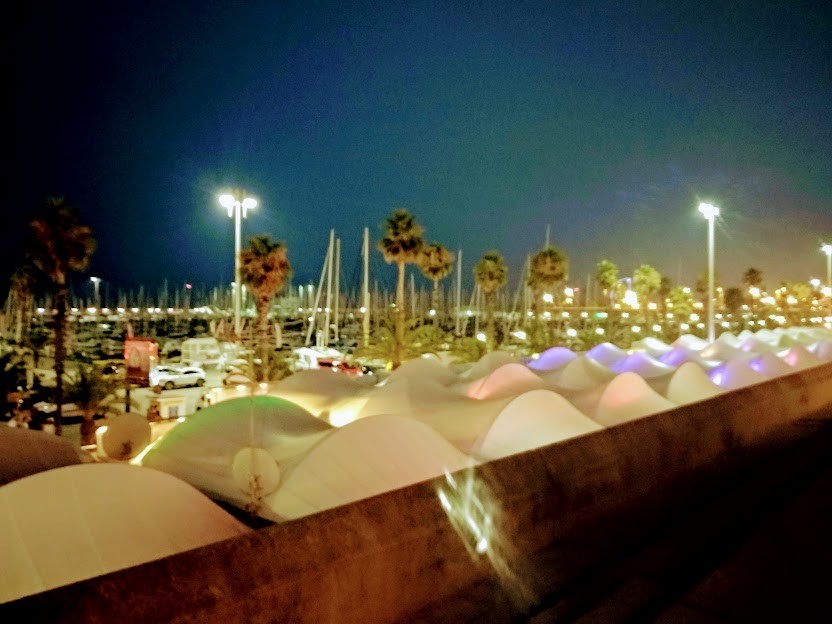
4- La Boquería Market
A gastronomic emblematic place that attracts much visitors in a day, La Boquería, is perhaps the most famous food market in the world, and for a very good reason. Its endless alleys attract visitors with abundant stalls of the best cheeses, charcuterie, seafood and other products of the region. Some vendors have adapted to the demands of tourists over time, but to get a taste of what was once La Boquería, head to Pinotxo Bar, where there is one of the best tapas in Barcelona (or least of the best from La Boquería), such as the amb cigrons botifarra negre (chickpeas cooked in black pudding) or the amb mongetes squid (tender squids and white beans) for half a century. The market of La Boquería is open from Tuesday to Thursday from 8h to 15h, Friday and Saturday from 8h to 17h and closed on Sunday and Monday.
5- Neighborhood Barri Gòtic
There is approximatively no place on earth that can be compared to Barri Gòtic in terms of the concentration and scale of Gothic architecture. It is the oldest part of the city, where the labyrinthine streets flow through medieval plazas like the beautiful Plaça del Rei. Yet, despite its old and authentic side, Barri Gòtic has some of the best shops in the city. "Espadrilles" made by hand are for example an excellent souvenir to take home. You can find some at The Manual Alpargatera. To make more rare discoveries, wake up early on a Sunday morning to explore the Mercat Gòtic, where you can go hunting for antiques and, if you're lucky, attend a traditional Catalan dance in the big square near La Rambla. The Gothic Quarter is bordered by La Rambla, a shaded pedestrian boulevard that leads down from Plaça de Catalunya to the amazing Port where beside the wonderful boats we can discover the Maremagnum commercial center. People can not be bored because La Rambla is very lively, not street artists in particular. However, it is also a famous place to attract pickpockets, so people must take big pay attention to their belongings. At the bottom of the boulevard, we can also admire the Columbus Column statue centering the big area.
6- Plaza de España and Cataluña
The Placa de España is a monumental square located at the foot of Montjuïc Hill and impresses with its size and layout. It contains two towers, inspired by the campanile of St. Mark's Basilica in Venice, and a fountain by Jujol, which is the allegory of the rivers of Spain.
Catalunya Square is also one of its main venues in downtown Barcelona and is also one of the largest squares in Spain where we can find the commercial center of the Las Arenas and the two tours offering an amazing view. The place is also a high place of life in Barcelona, it marks the starting point of major arteries such as Las Ramblas which is the main avenue of the city, Paseo de Gracia which is a parallele street to the Rambla where we can discover also many beautiful shops and malls. Its esplanade hosted throughout the year shows, exhibitions, but also trade fairs and popular gatherings. Its surroundings are also one of the main commercial areas of Barcelona and the logistics platform of many means of transport. The square is characterized by a gigantic central space surrounded by gardened and wooded areas. In the middle, two twin fountains are separated by a terrace with several sculptures of great artists, mainly Catalan.

The monumental fountain that presides Plaza España is one of the most emblematic images of this Barcelona place. All the angles of the place are good to observe this monument of classic invoice and impacting effect. A sculptural group indicates the exit towards the passage of the zone where was celebrated the International Exhibition. When the Barcelona International Exhibition was inaugurated, the monumental fountain that was to preside over the entrance to the enclosure was not yet finished. Work had just begun in January of the same year. Designed by architect Josep Maria Jujol, one of Gaudí's principal collaborators, the fountain is a great allegory that pays tribute to water. It takes the first role in the various sculptural ensembles that decorate it in a noucentist style (cultural movement of political significance begun in Catalonia at the beginning of the twentieth century) classic.
7- Hospital de Sant Pau
I had the chance during my trip to visit the monumental Hospital de Sant Pau. This surprising hospital was created with the aim of resembling a small modernist village whose function was to contribute to the healing of patients in a pleasant environment. The impressive red-brick buildings were really amazingly beautiful, more like beautiful country houses in the middle of a charming environment. Each of the hospital's specialties had its own building and all were connected by underground pavilions. An important information for people wanting to visit it, the entrance is free on Sunday. Taking a guided tour, people can walk through some areas of the hospital complex and the gardens, as they can discover very interesting details about the hospital and how were people treated in the city in the 20th century. The visit begins in the Pavilion of Sant Jordi, where people can find an exhibition on the past, the present and the future of the hospital.
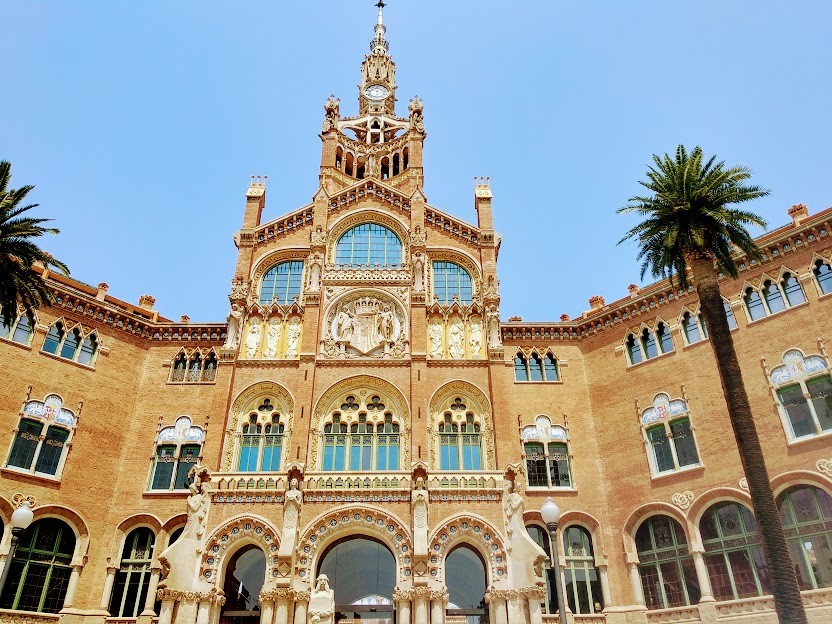
People can then visit the interior of the church and various pavilions of the hospital while discovering curious stories that took place in this place. The tour ends with a tour through the underground tunnels connecting the buildings to each other.
Photo gallery
Content available in other languages
Want to have your own Erasmus blog?
If you are experiencing living abroad, you're an avid traveller or want to promote the city where you live... create your own blog and share your adventures!
I want to create my Erasmus blog! →





















Comments (0 comments)